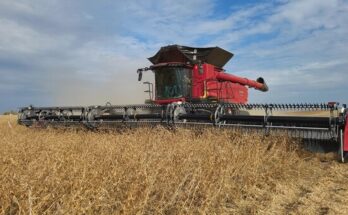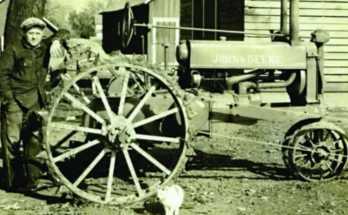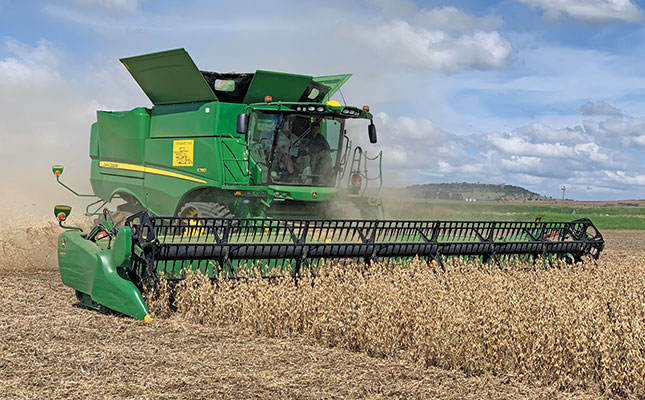
The John Deere S780 combine harvester was showcased during a demonstration tour in Winterton, KwaZulu-Natal, this past April.
Photo credit: John Deere South Africa
Scotland is credited with the early invention of the combine harvester. In 1826, the Rev. Patrick Bell designed a reaper machine that used scissor-like blades to cut crops. It was a large, horse-drawn device, but Bell never patented his creation.
In 1834, American inventor Hiram Moore built and patented the first true combine harvester. That same year, another American, Cyrus McCormick, patented his mechanical reaper, also known as a sickle bar mower. Moore’s combine, pulled by horses or mules, was capable of reaping, threshing, and winnowing grain. By 1839, a 20-horse-drawn version harvested over 20 hectares in a single day, showcasing its efficiency.
By the 1860s, harvesters with multi-meter-wide cutter bars were widely used on U.S. farms, paving the way for more advanced mechanization.
The 20th century saw a significant shift toward combine harvesters due to labor shortages and the efficiency they offered. The trend was fueled by the growing size of farms, which made mechanization both practical and cost-effective compared to hand-harvesting.
This pattern was mirrored in South Africa. Between 1968 and 1981, mechanical harvesting in the Western Transvaal rose dramatically from 30% to nearly 95% of the grain crop, illustrating the rapid adoption of this transformative technology.
1 The Ransomes combine
My journey with combine harvesters began in 1960, when I sold my very first machine: the Ransomes 902, introduced at the 1957 Smithfield Show.
At the time, Ransomes combines were considered cutting-edge, boasting an impressive output of up to 6 tons per hour—nearly double the capacity of many competing models.
The Ransomes 902 was manufactured under license from the original designer, Sweden’s Bolinder-Munktell, a collaboration that brought innovation to the market. Alongside the self-propelled 902, Ransomes also produced the MST56, a trailed combine designed to meet a variety of farming needs.
Pictured here is the Ransomes Sims & Jefferies 902 self-propelled combine, a machine that set new standards in its day and remains a testament to the engineering excellence of its era.

2 Sunshine in South Africa
In 1843, Australian farmer JW Bull made an important contribution to agricultural mechanization by inventing the grain stripper. Nearly four decades later, in 1882, 17-year-old Australian Hugh McKay achieved a significant breakthrough with his concept for the stripper harvester.
This revolutionary machine, capable of stripping, threshing, winnowing, and bagging grain, was first successfully operated on McKay’s family farm in Drummartin, Victoria.
The Sunshine harvester, McKay’s design, dominated Australian farming until 1913, when Headlie Taylor introduced an improved version. Impressed by Taylor’s innovation, McKay acquired the rights to the new design. By 1916, the Sunshine Header Harvester was in mass production, solidifying its place in farming history.
Taylor continued to innovate, creating the first motorized harvester in 1924. By 1927, the Sunshine Autoheader became the world’s first self-propelled harvester to be widely adopted.
The Sunshine Header is believed to be the first combine harvester used in South Africa. Today, examples of this historic machine can be viewed at the museum hall at Nampo and the Vintage Club in Baynesfield, KwaZulu-Natal.
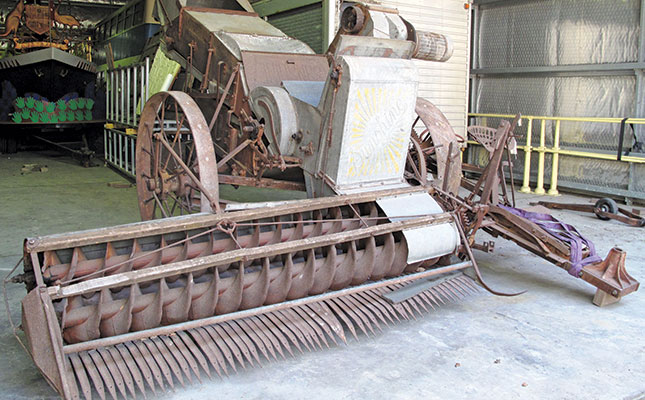
3 European breakthrough
In the early 1930s, German agricultural pioneer August Claas, in collaboration with Walter Brenner from the University of Bonn, developed a prototype combine specifically designed to handle Europe’s heavy and often damp crops—conditions that challenged American-made machines.
By 1936, Claas introduced the MDB, a trailed combine harvester equipped with a side-mounted cutterbar. This groundbreaking machine was the first fully functional combine harvester produced in Europe and could harvest up to 30 tons of wheat per day under favorable conditions.
Before its replacement in 1946, approximately 1,450 MDB units were in operation worldwide. The successor, the Claas Super, became a global success, with machines sold in countries like South Africa.
Production of the Super continued until 1972, with over 65,000 units sold, including the Super Junior, a smaller model launched in 1953 to meet the needs of small-scale farmers. The Claas Super series remains a landmark in agricultural mechanization, blending innovation and adaptability for farmers worldwide.

In the same year, after strenuous testing, Claas launched its first self-propelled combine, the Hercules, which proved a resounding success.
4 Top of the line
Claas asserts that its newly launched Lexion 780 redefines combine harvester technology, thanks to its advanced CEMOS Automatic driver assistance system.
This cutting-edge software allows farmers to set specific default values, which the system quickly analyzes to determine the optimal settings for current threshing conditions.
As conditions shift throughout the day, sensors continuously monitor the changes, and the system automatically adjusts the combine’s settings in real-time, optimizing performance second by second. This innovation ensures maximum efficiency and productivity, regardless of the challenges in the field.
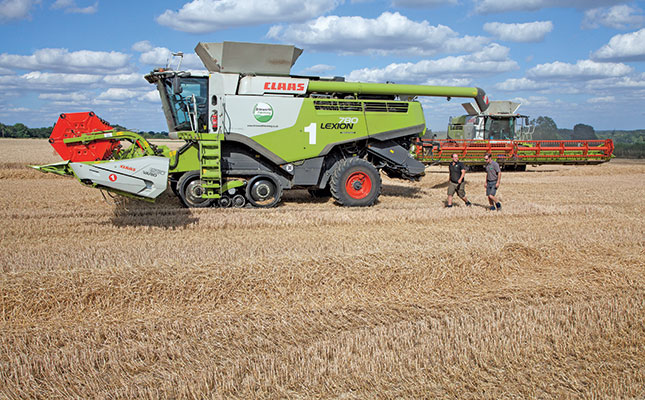
5 Self-propelled Massey-Harris
In 1936, Tom Carroll and his research team at Massey-Harris (now known as Massey Ferguson) in Ontario, Canada, embarked on developing the first commercially viable self-propelled combine.
Their work led to the creation of the Model M-H 21, which was launched for sale in 1941. This model was notable for being relatively lightweight and affordable, making it an attractive option for contractors. Its design allowed it to be easily loaded onto a truck, adding to its practicality and appeal in the farming industry. The M-H 21 was a significant milestone in agricultural machinery, contributing to the widespread adoption of self-propelled combines.
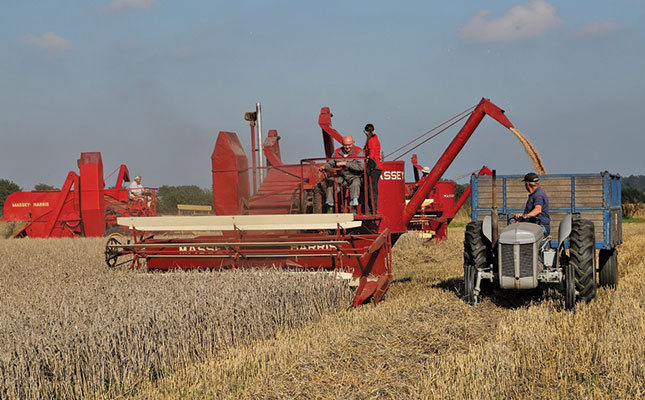
6 The IDEAL
For decades, Massey-Harris, and later Massey Ferguson, held a prominent position as global leaders in the combine harvester market. Today, AGCO, the parent company of Massey Ferguson, is striving to reclaim that top spot with the introduction of the IDEAL combine (pictured here). This new model showcases AGCO’s commitment to innovation and excellence in agricultural machinery, aiming to redefine performance and efficiency in modern harvesting.

The company developed the machine based on critical factors such as reliability, ease of repair, parts availability, convenient and intuitive controls, and operating efficiency.
The MF IDEAL, also badged as ‘Fendt’, has a single rotor and a 12 500ℓ grain tank, and is powered by a 338kW AGCO Power 9,8-litre engine. It remains to be seen if it will make its way to South Africa.
7 The Axial Flow
In 1977, International Harvester (now Case IH) introduced the Axial Flow harvester, revolutionizing traditional combine harvester design. Unlike previous models that relied on a drum and straw walkers, the Axial Flow utilized a rotor to carry out the threshing and separation processes.
The rotor, a spinning cylinder within the machine, effectively threshed the grain, leading to a significant boost in productivity and efficiency. This innovative rotary design was the first of its kind to be mass-produced, and the patent provided International Harvester with a competitive advantage in the market, setting a new standard for combine harvesting technology.

This impressive publicity photograph shows the combines at work in Brazil. South America currently has what is probably the third-largest share of the world’s self-propelled combine market after North America and Europe.
8 The Sampo
This compact combine harvester was available in South Africa during the 1970s, catering specifically to owner-farmer operations. Given the recent developments with Japan’s Kubota Group becoming the major shareholder in Sampo Rosenlew, based in Pori, Finland, this small combine may see a resurgence in the market. Kubota’s involvement could lead to renewed interest and innovation in this segment, potentially bringing the machine back to farmers seeking practical, efficient harvesting solutions.
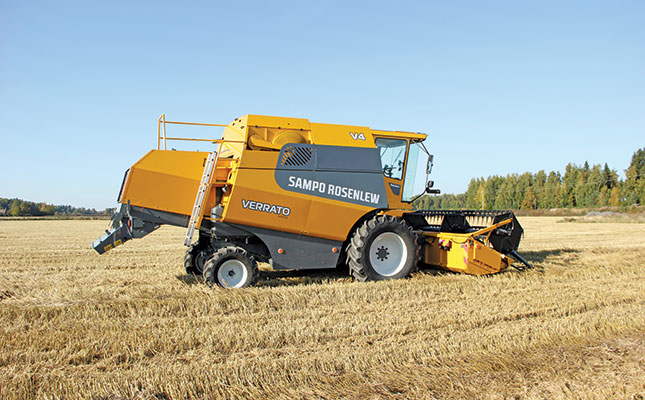
Sampo Rosenlew has produced more than 50 000 combines since production began in 1957, with more than 90% of its machines being exported to about 50 countries.
9 The Belgian Claeys
Claeys was established in 1906 by Leon Claeys, a Belgian mechanic, and initially focused on manufacturing threshing machines. By the 1960s, Claeys had grown to become one of Europe’s leading combine manufacturers.
In 1975, Sperry New Holland, which had acquired Claeys, launched the world’s first twin-rotor combine—a groundbreaking technology that continues to be utilized in modern harvesting equipment. The image above shows the CR10.90 model, showcasing the legacy of innovation that began with Claeys and evolved through its incorporation into New Holland’s product line.

10 Combine control system
The New Holland IntelliSense system elevates combine automation, offering a range of enhancements that reinforce the dominance of what is touted as the world’s highest-capacity combine harvester. This advanced system optimizes machine performance through real-time adjustments, improving efficiency, reducing grain loss, and ensuring optimal harvesting conditions. With IntelliSense, operators can rely on automated settings that adapt to changing field conditions, maximizing productivity and simplifying the harvesting process.
The proactive and automatic combine setting significantly improves the machine’s productivity, increasing daily output, reducing grain loss and improving grain quality.
Moreover, the operator has to make fewer decisions.
more detail on https://www.farmersweekly.co.za/
